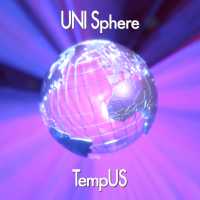Description
- The Calling for Dawn
- Le Temps Retrouve
- In Transition
- Reflections
- Post Meridian 11:35pm
- Technical Instrument for Measurement of Existence
- Reunification
Unisphere are Rene Splinter and Eric v.d. Heijden. Majestic, warm and melodic full in the style of both musicians. TD fans should not miss this, the vibe of the Early 80’s are here!!





Sylvain Lupari –
It was in 2015 that Unisphere established their mark in the contemporary electronic music (EM) chessboard with a brilliant debut album entitled Endless Endeavor. Heavily inspired by the Schmoelling years of Tangerine Dream, Rene Splinter and Eric van der Heijden also had some Vangelis influences to wash over this first album which was very well received by critics, including me, and fans of the genre. The two companions are doing it again some 6 years later with an album that combines rhythms, melodies, atmospheres, percussive elements, a lot of them, and raging synth solos in a 65 minutes of explosive EM. All these qualities together make TempUs to be considered as the most beautiful and accessible EM album in 2021. Available from Groove nl in manufactured CD and downloadable format, this little EM gem is the work of two excellent melodists. Beautifully structured, the music is of this narrative race with choruses and verses which clash in e xchanges without words, but which mean everything.
With a reverberating ray and the chirping of birds, The Calling for Dawn offers a slow, atmospheric introduction. Voice effects are grafted onto this opening, which gets more and more amplified when it is absorbed by a large organ layer that tops it and propels it to the 3rd minute. Deafening blasts resound, spreading a cloud of sonic dust from which seraphic voices emerge. In fact, it takes almost 4 minutes for The Calling for Dawn to give a sign of rhythmic life. And even then, this rhythm is hesitant. Not knowing what chord to dance to, it lets a delicate flute whisper to our ears the promise of more energetic structures to come. This is the case one minute later. Taking advantage of the support of the percussive elements and electronic percussion, the sequencer alternates its keys more vividly in a stationary rhythmic structure. The bouncing keys get clumped together in a dense mass and jump briskly, nervously along a l arge oblong line that slowly undulates. Synth solos overlay this static feverishness of the sequencer, weaving harmonious shapes. After this track, the thing that jumps out at you is the power of percussions and sequencer in TempUs’ music. Le Temps Retrouve plunges us into a melancholic ambience with notes thrown on the pavement by a cynical pianist. Among the resonances they scatter, a dramatic veil is woven, helping the pianist to move in this direction. This track, which breathes the influences of Johannes Schmoelling, starts with a delicate rhythm, always supported by metallic percussive effects, on good arrangements, including a magnificent fluty mellotron. Little by little, Le Temps Retrouve detaches itself from these artistic constraints with a galloping rhythm and a structure of lively sequences, as if struck by a goldsmith having 4 hands, before undertaking its last third with very good solos on a structure that has become a bit jerky. After a 60 seconds of naval ambiences , In Transition go off with a bang with a sequencer unleashing its line of bass sequences and another line of keys jumping briskly in ostinato in a movement where these lines crisscross while describing undulatory axes. The flow is either lively or jerky and gallops in a spasmodic way under very good solos that bewitch my ears. Becoming a bit disordered, the rhythm spreads a carpet of small nervous steps in a structure that sounds so much like Tangerine Dream that I had my jaw dropped. The solos, multiple I must specify, are sometimes suave and at other times high-pitched as if they were whistled. It sounds like a junction between Schmoelling and Paul Haslinger, with Chris Franke at the sequencer. It’s mind blowing of truth!
Reflections is the only ambient track on TempUs. It’s also a long nebulous introduction to the colossal Post Meridian 11:35pm. The percussions come in to roll awkwardly over the resonant carpet of Reflections’ ambiences. This rhythm is particular to us b ecause we heard it in TD’s Jive years! The sequencer makes pulse a key as the orchestrations envelop this texture enhanced by the keyboard. An initial floating harmony from the synth sings us the apple with strident emotive peaks that obnubilate our senses. The electronic drums and the sequencer continue to hammer the rhythm and the ambiences that awaken in us memories of The Keep. The solos, always so sharp, lead us to a second part of Post Meridian 11:35pm which is definitely more intense and more dramatic. It’s quite a whole track with magical solos. A slightly reverberating shadow is watching for our ears as Technical Instrument for Measurement of Existence opens. Its floating momentum drops sparse limpid chords from a musing keyboardist while all around lurk bluish filaments. This slow introduction is timed so that the rhythm starts to shake our speakers around the 3rd minute. This phase unfolds like a new Poland. Jerky bass string, spontaneous percussions, gauzy cymbals and a sequencer which runs away with keys hopping like eggs on a conveyor belt, the rhythm is of the stop-and-go style under the regurgitation of this hovering shadow. Suddenly, the time stops to let freedom to a plethora of percussive effects, sequences and oriental percussions to scroll under powerful atmospheric riffs. Still without a precise direction and hanging on to a ticking of a big wooden clock, Technical Instrument for Measurement of Existence ends up exploding somewhere after the 7th minute to offer an ambient rhythm conducive to succulent synth solos. Reunification closes TempUs in a fusion between up and down tempos. The percussions still play an essential role in what becomes a good electronic rock cut in narrative music mode that is decorated by good synth loops and very good solos of a synth that wants to be melodious to every overexcitement phase of the sequencer and of the electronic percussions.
Although some phases are totally crazy, I think of the rhythms sh ot by sequenced machine gun bursts and the synth solos played like Johannes Strauss’ violins, TempUs is built in such a way that Unisphere integrates us in a familiar universe to offer the most progressive music in its last 22 minutes. A very well-structured album by the duo Rene Splinter and Eric van der Heijden which offers us certainly the most complete and melodic album of 2021, while bringing us closer around the wonderful memories of the Dream.
2022. Sylvain Lupari
Monika Freerk / Deutschland –
Fantastic, emotional Tracks with wonderful sounds and genious leadvoices.Definatly worth to have <3
2021. Monika Freerk / Deutschland
Paul Rijkens – Dutch progressive rockmagazine iO Pages –
At the time of writing this review, mid-October 2021, it is a week prior to the E-Live festival. Finally, there is another electronic music festival in the Netherlands after a two-year break. I am really looking forward to the concert by UNI Sphere, the duo consisting of Eric van der Heijden and Ren Splinter. Their first album Endless EndeavoR was released in 2015. That was an excellent CD with wonderful melodic electronic music. It was an album that managed to bridge the gap between the music of Tangerine Dream from the early eighties and Vangelis. On TempUS, the gentlemen go even further. The theme of TempUS is that we are all only temporary. Armed with a cool list of equipment Eric and Ren have once again delivered great disc. Superb choral sounds introduce the album in The Call For Dawn, after at some point sequences take over. The ones in the second part of the piece remind me of Tangerine Dream’s Logos and Poland period. Well done! T h e guys -and Ren in particular- are big fans of TD from that time. This can be heard on the album well. Le Temps Retrouv starts with calm, slightly melancholy, melodic piano sounds and furthermore has beautiful melody lines. Sequences also play an important role in In Transition. Reflections starts off calmly and relaxed, before on Post Meridian (11.35 pm) TDs Poland comes into mind again. Also, in Technical Instrument For Measuring Of Existence I hear a hint to TD, but then more the symphonic music from their first period with Paul Haslinger (for example the album Underwater Sunlight). The eighties can also be heard in REunification, but in my opinion this rhythmic song has more of a slight hint to the synthpop of that time (without vocals then). I really listened this album with admiration and amazement. It is one of the highlights in electronic music of the almost past year. These guys can play and compose!
2021, Paul Rijkens – Dutch progressive rockmagazine iO Pages
Bert Strolenberg/SonicImmersion.org –
Some 6 years ago Eric van der Heijden and Rene Splinter surprised the EM scene with their project Uni Sphere and its fine debut EndLess EndeavoR. The latter proved a solid, well-made and highly emotive work of sonic art sketching out various moods and atmospheres. After a lot of hard work and perseverance theres TempUS, a concept album dealing with the fact that (everything in) life is temporary.
To reflect on that, both musicians composed 65 minutes of imaginative and narrative music that unfolds slowly through fields of in-depth textural landscapes, enticing melodic lines and sequences patterns while elements of Johannes Schmoellings sound design shines through occasionally. The music shifts into more dynamic mode on In Transition, a typical Rene Splinter track, opening with up-tempo sequences before shifting to a smoother pace while warm melodies are released. The 7-minute Reflections is all about creating fluid, melancholic -infused textural spheres before drums, sequences as well as a smooth solo kick in on Post Meridian (11:35 pm). From there the sound design builds gently along some Schmoelling-esque solo voices surfacing now and then. The realm of 80s TD also applies to the futuristic Technical Instrument for Measurement of Existence where a pleasant bit of sound experimentation is going on paired with heavy drums and brief melodic lines. The 11-minute Reunification rounds out the fine release in an up-tempo fashion with various tempo changes and very nice sequencer patterns at work as well as some fine solos. All in all, I have no doubt TempUS will appeal to and be appreciated highly by a wide Em-audience out there.
Overall rating: between 3.5 & 4 stars
2021. Bert Strolenberg/SonicImmersion.org